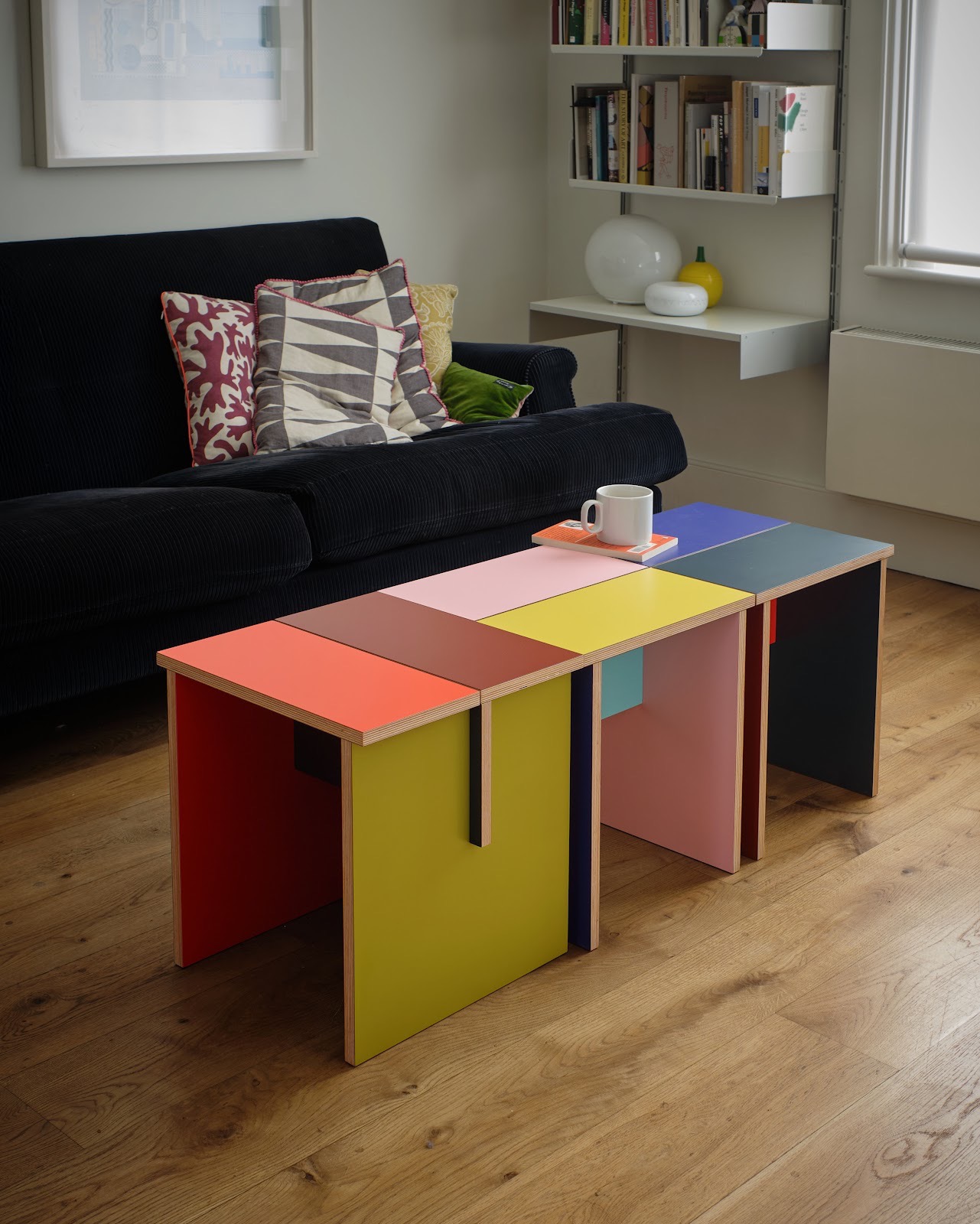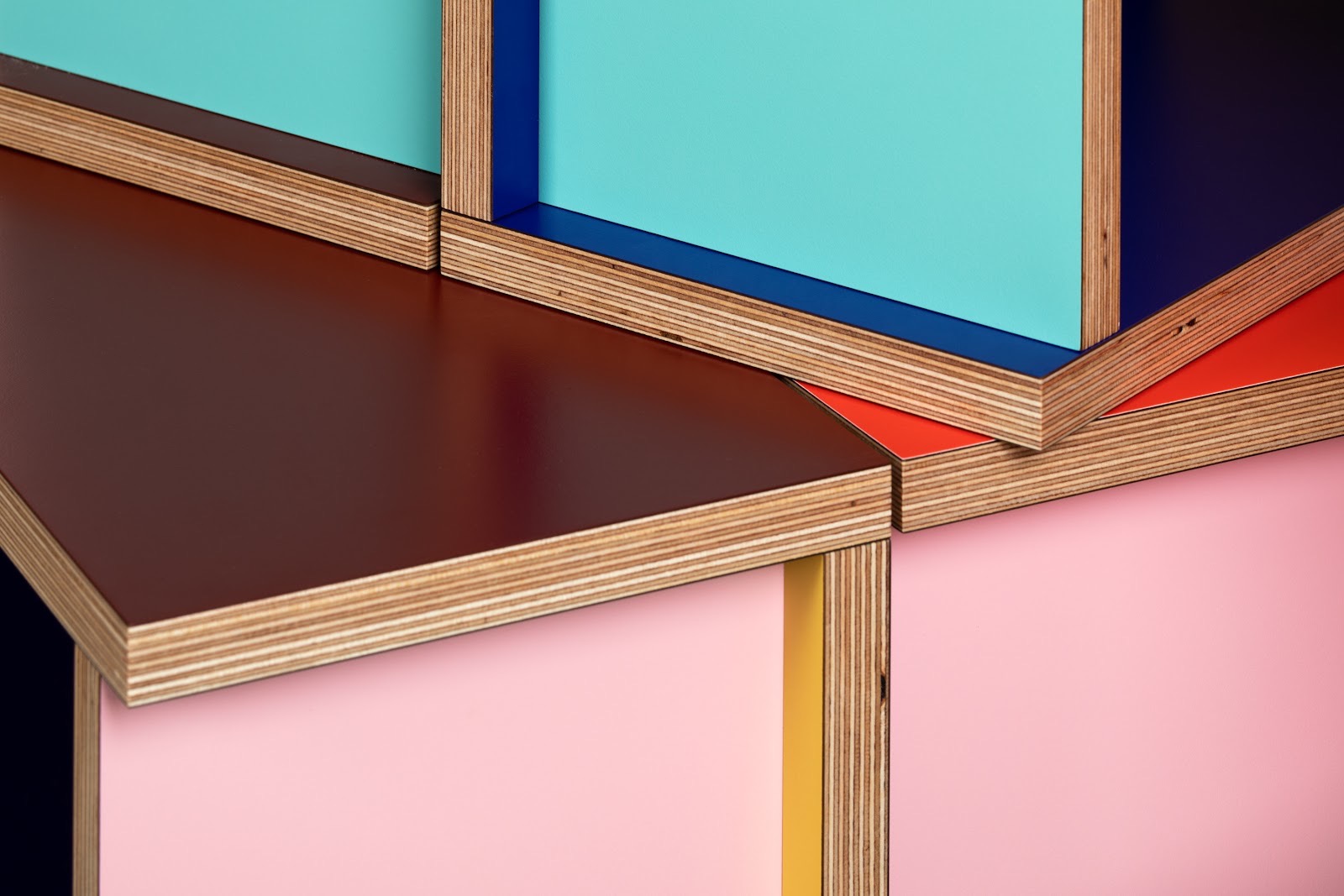
“I like limitations,” says artist-designer Sophie Smallhorn. “I’m always looking for an edge to work against.” That edge, in this case, was plywood, the material that defines our kitchens and furniture. Working together, we turned the limitations of the 4×8ft sheet into something sculptural, efficient and joyful: the Combination table. Portrait by Ruth Ward
Although Sophie is best known for her vividly ordered wall compositions, her background is in furniture design. She studied at Brighton College of Art, majoring in wood and minoring in plastics, before moving into a career defined by colour. Our collaboration marks her first return to furniture since then.
The project began with an earlier collaboration: a simple poster hanger made from offcuts from our workshop. From that modest start grew a more ambitious idea…a piece that could express colour through form while staying true to our precision-made approach. Every dimension of the Combination table was defined by how to achieve the most from each sheet of plywood with the least waste. “They’re designed to be made very efficiently,” says Sophie. “It’s an economy of making that I find both limiting and liberating.”
Flat-packed and easily assembled, the table is built from birch plywood with coloured laminate on both sides, its construction held together by discreet knock-down fittings. The result balances playfulness and precision, what Sophie describes as “a sculptural piece with a small notion of function thrown in.” Used on its own or in combination, the tables form a modular landscape of colour and geometry, designed to be turned, rearranged and lived with over time.

The limitations of the plywood sheet became the project’s defining logic. Each table was proportioned to fit precisely within the 4×8 format, and the colour palette of four distinct combinations emerged from that same efficiency. “The number of colours and variants was dictated by the material yield,” Sophie explains. “It’s about making within the bounds of a system, and finding expression in that.”
This process, she says, mirrors her studio practice, where rules and grids often act as the foundation for visual harmony. “When you take away excess choice, you focus more sharply on what’s there,” she adds. “You notice subtleties, tone, edge, proportion.”
For us, the appeal lay in translating those artistic instincts into a precise manufacturing process. “Sophie’s approach resonated deeply with how we work,” says co-founder Alan Drumm. “We design within material limits every day, understanding how to use the sheet material efficiently, how each cut or joint adds to the integrity of the piece. This project was about letting that discipline show, but also having fun with it.”

At our London workshop, every table is CNC-cut and hand-finished to the same exacting standard as our Bespoke and Core kitchens. The contrast between digital precision and pops of colour gives Combination table its character: engineered yet human, rigorous yet inviting. The exposed ply edges reveal the layered structure of our favourite material, while the vibrant laminate surfaces carry Sophie’s unmistakable sense of colour and balance.
For Sophie, our partnership offered both reassurance and discovery. “Precision has always been central to my work,” she says. “Uncommon’s accuracy and attention to detail are completely in tune with my practice…it’s what made the collaboration feel so natural.” She describes the collaboration as a conversation between analogue and digital: her hand-built models meeting their parametric design software. “It was iterative,” she says. “We’d test an idea, check the cut, re-balance the colour. There was a real back-and-forth.”

Beyond its geometry, Combination Table also invites play, which is a new dimension in Sophie’s work. “People always ask if they can move the colours around in my sculptures,” she says with a smile. “And the answer is always No! But here, they finally can.” The table’s modularity encourages owners to arrange and rearrange configurations, creating shifting relationships between colour and form.
This openness to colour as something to interact with rather than observe aligns perfectly with our philosophy. “Our kitchen designs are part of everyday life,” says co-founder James Hoy. “They’re not precious; they’re practical, but in a way that celebrates detail and care. The idea that you can play with colour and interact with material feels very Uncommon.”
The collaboration made its public debut in Sophie Smallhorn: Recent Work at Timothy Hatton Architects, The Foundry, London W12. Displayed alongside her wall-mounted compositions, the tables reveal a shared visual language: flat planes of colour translating from vertical to horizontal, from static to interactive.
For us, the exhibition was a chance to see our work in a new context. “We’re used to our designs living in homes,” says Alan/James. “Seeing them in a gallery setting reframed what we do. It reminded us that precision and craft can be expressive in their own right.”

Combination table follows our collaboration with John Booth and marks the next step in a growing programme of creative collaborations on our Objects. Each project explores the boundaries between art, design and making, a reflection of our belief that creativity thrives within constraints.
As Sophie puts it: “Boundaries make you think harder. And they often lead to better work.”
Keep reading our design guides, product advice and stories from our Uncommon friends.